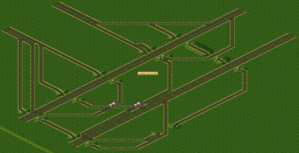Difference between revisions of "Backbone Hub"
From #openttdcoop wiki
| Line 1: | Line 1: | ||
[[Image:BBH.png|thumb|right|An example Backbone Hub]] | [[Image:BBH.png|thumb|right|An example Backbone Hub]] | ||
| − | A backbone hub (BBH) is the largest type of [[Guides:Glossary:Hub|Hub]] that is built in #OpenTTDCoop. It usually consists of at least 3 cardinal directions of [[Basic_Networking#Mainline (ML)|mainline]] Track, and is also usually [[ | + | A backbone hub (BBH) is the largest type of [[Guides:Glossary:Hub|Hub]] that is built in #OpenTTDCoop. It usually consists of at least 3 cardinal directions of [[Basic_Networking#Mainline (ML)|mainline]] Track, and is also usually [[Balancing|balanced]] as well. More information on backbone hubs including building them is in the [[Guides:Mainline_Junctions|Mainline Junctions]] guide. |
== Function == | == Function == | ||
Revision as of 00:07, 23 October 2009
A backbone hub (BBH) is the largest type of Hub that is built in #OpenTTDCoop. It usually consists of at least 3 cardinal directions of mainline Track, and is also usually balanced as well. More information on backbone hubs including building them is in the Mainline Junctions guide.
Function
A BBH connects mainline segments to each other, most often in 4-way or 3-way junction patterns.
Requirements
A BBH must be:
